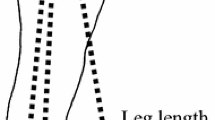Abstract
Generating a natural foot trajectory is an important objective in robotic systems for rehabilitation of walking. Human walking has pendular properties, so the pendulum model of walking has been used in bipedal robots which produce rhythmic gait patterns. Whether natural foot trajectories can be produced by the pendulum model needs to be addressed as a first step towards applying the pendulum concept in gait orthosis design. This study investigated circle approximation of the foot trajectories, with focus on the geometry of the pendulum model of walking. Three able-bodied subjects walked overground at various speeds, and foot trajectories relative to the hip were analysed. Four circle approximation approaches were developed, and best-fit circle algorithms were derived to fit the trajectories of the ankle, heel and toe. The study confirmed that the ankle and heel trajectories during stance and the toe trajectory in both the stance and the swing phases during walking at various speeds could be well modelled by a rigid pendulum. All the pendulum models were centred around the hip with pendular lengths approximately equal to the segment distances from the hip. This observation provides a new approach for using the pendulum model of walking in gait orthosis design.








Similar content being viewed by others
References
Alexander RMcN (1976) Mechanics of bipedal locomotion. In: Davies PS (ed) Perspectives in experimental biology. Pergamon, Oxford, pp 493–504
Alexander RM, Goldspink G (1977) Mechanics and energetics of animal locomotion. Halsted Press, New York
Anderson SO, Wisse M, Atkeson CG, Hodgins JK, Zeglin GJ, Moyer B (2005) Powered bipeds based on passive dynamic principles. 5th IEEE-RAS international conference on humanoid robots, 110–116
Banala SK, Hun SK, Agrawal SK, Scholz JP (2009) Robot assisted gait training with active leg exoskeleton (ALEX). IEEE Trans Neural Syst Rehabil Eng 17:2–8
Coope ID (1993) Circle fitting by linear and nonlinear least squares. J Optim Theory Appl 76:381–388
Emken JL, Harkema SJ, Beres-Jones JA, Ferreira CK, Reinkensmeyer DJ (2008) Feasibility of manual teach-and-replay and continuous impedance shaping for robotic locomotor training following spinal cord injury. IEEE Trans Biomed Eng 55:322–334
Esquenazi A, Packel A (2012) Robotic-assisted gait training and restoration. Am J Phys Med Rehabil 91:S217–S231
Fang J (2013) Computer modelling and experimental design of a gait orthosis for early rehabilitation of walking. PhD Thesis, University of Glasgow, Glasgow
Fang J, Gollee H, Galen S, Allan DB, Conway BA, Vuckovic A (2011) Kinematic modelling of a robotic gait device for early rehabilitation of walking. Proc Inst Mech Eng [H] 225:1177–1187
Freivogel S, Schmalohr D, Mehrholz J (2009) Improved walking ability and reduced therapeutic stress with an electromechanical gait device. J Rehabil Med 41:734–739
Gard SA, Childress DS (2001) What determines the vertical displacement of the body during normal walking? J Prosthet Orthot 13:64–67
Hansen AH, Childress DS, Knox EH (2004) Roll-over shapes of human locomotor systems: effects of walking speed. Clin Biomech 19:407–414
Harkema SJ (2001) Neural plasticity after human spinal cord injury: application of locomotor training to the rehabilitation of walking. Neurosci 7:455–468
Hesse S, Waldner A, Tomelleri C (2010) Innovative gait robot for the repetitive practice of floor walking and stair climbing up and down in stroke patients. J NeuroEng Rehabil 7:30
Kadaba MP, Ramakrishnan HK, Wootten ME (1990) Measurement of lower extremity kinematics during level walking. J Orthop Res 8:383–392
Kasa I (1976) A circle fitting procedure and its error analysis. IEEE Trans Instrum Meas 25:8–14
Kuo AD (1999) Stabilization of lateral motion in passive dynamic walking. Int J Robot Res 18:917–930
Kuo AD, Donelan JM (2010) Dynamic principles of gait and their clinical implications. Phys Ther 90:157–174
Kwan M, Hubbard M (2007) Optimal foot shape for a passive dynamic biped. J Theor Biol 248:331–339
McGeer T (1990) Passive dynamic walking. Int J Robot Res 9:62–82
Mochon SM, McMahon TA (1980) Ballistic walking. J Biomech 13:49–57
Perry J (1992) Gait analysis: normal and pathological function. SLACK Incorporated, New Jersey
Winter DA (1992) Foot trajectory in human gait: a precise and multifactorial motor control task. Phys Ther 72:45–53
Winter DA (2005) Biomechanics and motor control of human movement, 3rd edn. Wiley, New York
Wisse M (2004) Three additions to passive dynamic walking; actuation, an upper body, and 3D stability. 4th IEEE/RAS international conference on humanoid robots 111: 113–132
Acknowledgments
The first author was the recipient of a scholarship from the China Scholarship Council for PhD study in the School of Engineering, University of Glasgow [8].
Author information
Authors and Affiliations
Corresponding author
Rights and permissions
About this article
Cite this article
Fang, J., Hunt, K.J. Foot trajectory approximation using the pendulum model of walking. Med Biol Eng Comput 52, 45–52 (2014). https://doi.org/10.1007/s11517-013-1117-7
Received:
Accepted:
Published:
Issue Date:
DOI: https://doi.org/10.1007/s11517-013-1117-7




